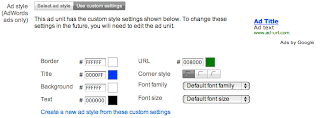Money for nothing? Well, not quite—but close! Google’s AdSense is a revenue-sharing opportunity for small, medium and large web sites that places ads for goods and services that are relevant to the content of your site, targeted to the people who frequent your pages. In turn, you get paid a small amount when the ad is either displayed on your page, or clicked on. We'll show you some good ideas that added to your own, will help increase your AdSense revenue.
Creating an Ad Unit
1. Sign into your Adsense account.
Go to AdSense, and click on My ads in the upper left.
Create a new Ad unit. In the main screen area, under Content > Ad units, click the +New ad unit button.
2. Name your ad unit.Go to AdSense, and click on My ads in the upper left.
Create a new Ad unit. In the main screen area, under Content > Ad units, click the +New ad unit button.
This can be any name that suits you, but many find creating a standard naming format helps them manage large amounts of data.
For example, using [target site for the ad]_[ad size]_[ad date] is one approach, that would look like this: mywebsite.com_336x280_080112. Whatever format you decide to use for naming, make that your standard.
3. Pick a size.
See "How to Do It" below for details, but Google has found best practices that generate more clicks.
4. Set your ad type.
This determines the types of ads you will see on your website: text only; text and image/rich media; and image/rich media only.
5. Create a custom channel.
A custom channel lets you group ad units however you choose, such as by size or location on a page.
You can track performance by custom channel, and turn your channel into a targetable ad placement so advertisers can target their ads to your ad units.
6. Create your ad style.
This lets you choose colors for the various components of an ad: border, title, background, text, and URL. It also lets you choose corner styles, from square to very rounded, a font family, and a default font size.
It's good practice to create an ad style that harmonizes with the look and colors of your website.
You can use Google's presets, or use your own custom settings. In either case, a sample ad on the right will show you how your ad will appear
7. Get the code for the ad.
When you're done with the ad setup, either save your ad unit, or click the Save and get code button at the bottom to get the HTML code for your site.
If adding code to your site is a puzzle you want help with, click here for Google's code implementation guide
How to Design Your Ad Campaign
In designing any kind of ad campaign, it's crucial to know who your target is. If you're writing a food blog that caters to single men on a budget, for example, you've narrowed the scope of who you will be appealing to. You've also got a very good focus point for your ads. What are things single men who cook drawn to? Here are some possibilities: dating, cars, movies, politics, and live music.
Think about who frequents your website, write down what you feel are the most important characteristics of your viewers.
2. Fine tune advertisements.
While AdSense will auto-populate your page with what they feel are relevant ads, use their tools to provide tighter controls.
Set up channels. Channels are like labels that let you group your ad units your way—by color, category, or pages. By setting up channels, you can get detailed reports on the performance of your ad units, and use that to your advantage. For example:
Use one style of ad on one group of pages, and another style on another group. Track and compare the performance of the two styles, and pick the best performer.
Compare performance on pages that focus on different things. For example, if your pages about gardening perform better than your pages on cooking, you might consider adding more to your gardening pages.
If you have separate domains, set up a channel to track each of them to see which is generating the most clicks.
3. Optimize your ad placement and site design.
Google has found there are places where ads are more effective, and places where they are less effective.
Ads that appear when you first arrive at your page (i.e., "above the fold" as they say in the newspaper world) tend to be more effective than those that are below the fold.
Ads on upper left tend to perform much better than ads on the lower right.
Ads directly above the primary content, and ads that appear at the bottom of the page and above the footer tend to perform very well.
Wider ads are generally more successful, as they are much easier to read.
Ads that display images or video perform very well.
Using colors that complement your website colors will make them more readable, and so more effective.
4. Learn how AdSense works.
AdSense automatically sends ads to your site based on a few different criteria:
Contextual targeting. AdSense crawlers scan your page, analyze your content, and serve up ads designed match your content. They do this using keyword analysis, word frequency, font size, and the link structure of the web.
Placement targeting. This allows advertisers to choose to run their ads on specific subsections of a publisher's website. If your website matches an advertisers criteria, their ad will appear on your page.
Interest-based advertising. This lets advertisers reach users based on their interests and the user's previous interactions with them, such as a visit to their website. Google's Ads Preferences Manager allows users themselves to choose their interest categories, which further helps advertisers focus their ad campaigns. This method is good for monetizing your site more efficiently, as it increases the value for advertisers and provides a more relevant experience for users.
What's it Worth?
1. Manage your expectations
When you sign up for AdSense, you'll want to know what kind of revenue can you expect to see. There is a lot that goes into what kind of return you can expect, and managing those things will help you maximize your earning potential.
2. Traffic
First and formost, in order to generate any kind of revenue from AdSense you must have people clicking on your ads. In order for this to happen, you need to have people on your site, reading your content! Whether you have a business website, or a personal blog, the rule is the same: Get the word out!
Heavily trafficked large sites can see over a million hits a day, whereas a blog might feel lucky if they have 100 visitors a day.
For every thousand page impressions (views) you receive, you may earn from $.05 to $5. Yes, that's a broad range—over a month, that is between $1.50 and $150.00! Where in that range you can expect to frequent depends entirely on you, your site, and your promotion efforts.
3. Cost Per Click (CPC)
This paid every time somebody clicks an ad on your page. No, you can't click your own ad—Google will see this, and shut you down so fast your head will spin. The advertisers set the price for these ads, and they can vary greatly.
An advertiser may spend a lot on a per-click basis, but that ad may generate very little interest on your site.
An ad that may generate $.03 per click may get 100 hits, but that doesn't add up to much.
4. Clickthrough Rate (CTR)
This is the percentage of visitors to your site compared to how many them actually clicked on an ad. If 100 people came to your site, and 1 of them clicked an ad, your CTR is 1%, and that's not an unreasonable number. You can see how getting more traffic to your site will really make a difference.
5. Revenue per 1000 impressions (RPM)
This is an estimate of how much you might receive if you have 1000 impressions (page views).
If you made, for example, $1 for 100 impressions, your RPM would be $10. There is no guarantee you'll make that, but it's a good way to check the overall performance of your site.
6. Content is king
The quality of your content is an important factor in understanding your earning potential. If your site provides rich, compelling content and a great user experience, you will have more interested users. Google's crawlers will also have an easier time determining the type of ad content would best fit on your site. Interested users + targeted ads = $$$
SEE ALSO
how to get blog traffic from twitter
best way to do keyword research
how to drive traffic to your blog
how to get page rank 14 tipsbest way to do keyword research
7. Start building keyword-rich pages
Liberally seed with well researched, profitable keywords, and get lots of high quality links to your site.
If your site is about topics such as debt consolidation, web hosting or asbestos-related cancer, you’ll earn much more per click than if it’s about free puppies.
If you concentrate only on top-paying keywords, you’ll face stiff competition.
What you want are keywords that are high in demand and low in supply, so do some careful keyword research before you build your pages.




